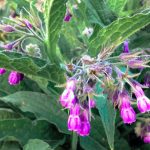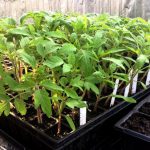Weekly Column – May 20th 2017
Comfrey Tea
As I keep my eye on the lush growth of the tomato plants, my thoughts turn to feeding these hungry plants. This is something that I will be doing every two weeks or so as soon as the plants start to produce fruit. Rather than buying liquid feeds, for some years now I have been making my own organic version by soaking the leaves of the comfrey plant. Comfrey is a perennial herb with big, broad hairy leaves that produce small purple flowers. It has long been used as a feed by organic gardeners, particularly the variety “Bocking 14”, named after the town of Bocking in Essex which was the original home of the organic gardening research association, Garden Organic.
Comfrey is a remarkably fast-growing plant and is one of nature’s great ‘miners’ – that is, it sends its roots deep in to the soil and brings up nutrients, most notably potassium, from deep in the subsoil. It is this nutrient in particular which will be of benefit to the tomato plants, and in fact all fruiting vegetables in the garden (for e.g. pumpkins, courgettes, squash etc). The basic idea of making a comfrey tea is to harvest leaves and soak them in water for about a month. This potassium-rich ‘tea’ is then applied as a feed to fruiting plants. I use a shears and literally cut the plant down to about 2 inches from the surface of the soil. Use a pair of gloves, as the leaves are a little prickly. You can harvest mature comfrey plants 3-4 times each year. It grows back quickly and can be cut again about a month later.
You should be able to source the plants from a good garden centre and then plant them out about 2ft apart. They will tolerate a shady, even damp spot in the garden. Mine are thriving in a corner of the garden behind the tunnel. Keep the bed well watered until the plants get established and don’t harvest leaves from it in the first year. Strangely, comfrey doesn’t seem to be able to mine the nitrogen very well that it needs for itself, being a fast-growing leafy plant (similar to a brassica). I generally mulch the plants when they die back in the autumn with lawn clippings.
In addition to making a comfrey tea (see below) you can also add comfrey leaves to the compost heap where they will accelerate the de-composition of your heap and add potassium. You can also use the leaves as a mulch, putting a layer of leaves around a plant where they will break down and release their nutrients more slowly. I’ve heard of people putting comfrey leaves in a trench when planting potatoes and also planting comfrey underneath fruit trees as a companion plant.
The Basics – Comfrey Tea
There are two ways to make a comfrey tea. You can either make a concentrated tea that will have to be diluted, or a ready-to-use version.
- Concentrate — Harvest comfrey leaves and shove them in a bucket with a lid. Weigh the leaves down with a brick or something else heavy. Drill a hole in the base of the bucket and place a container underneath. As the leaves rot down a black liquid will start to drip down from the bucket in to the container. This is your comfrey feed. Dilute one part comfrey liquid to 15 parts water.
- Ready to Use — Harvest your leaves and put them in a bucket. Fill the bucket with water until the leaves are covered. Cover with a lid and leave for 3-4 weeks. This type of tea is ready to use without diluting.




